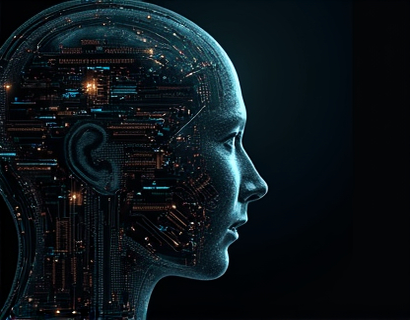Unlocking Next-Gen Ecosystem Engagement: Harnessing AI and Crypto for Transformative Digital Experiences
The digital landscape is undergoing a profound transformation, driven by the convergence of artificial intelligence (AI) and cryptocurrency. This synergy is not just a technological curiosity but a powerful force reshaping how users engage with digital ecosystems. For tech enthusiasts and investors, understanding this integration is crucial for navigating the future of digital interactions. This article delves into the transformative impact of combining AI and cryptocurrency to create more engaging, secure, and innovative digital experiences.
The foundation of this transformation lies in the unique properties of cryptocurrency and the capabilities of AI. Cryptocurrency, with its decentralized and secure nature, provides a robust framework for transactions and data exchange. AI, on the other hand, brings intelligent automation, predictive analytics, and personalized experiences to the table. When these two technologies are combined, they create a powerful ecosystem that can significantly enhance user engagement and satisfaction.
Enhanced Security and Trust
One of the primary benefits of integrating cryptocurrency into digital ecosystems is the enhanced security it offers. Cryptocurrencies use blockchain technology, which ensures transparency, immutability, and security of transactions. This level of security is particularly important in an era where data breaches and cyber threats are increasingly common. Users can trust that their interactions within the ecosystem are secure and their data is protected.
Moreover, the use of cryptocurrency eliminates the need for intermediaries, reducing the risk of fraud and increasing trust among users. Smart contracts, self-executing contracts with the terms directly written into code, further automate and secure transactions, ensuring that all parties adhere to the agreed-upon terms without the need for a central authority.
Personalized User Experiences
AI plays a pivotal role in creating personalized user experiences within digital ecosystems. By analyzing vast amounts of data, AI algorithms can understand user preferences, behaviors, and needs. This insight allows for the customization of content, recommendations, and interactions tailored to individual users. The result is a more engaging and relevant experience that keeps users coming back.
For instance, AI-driven chatbots can provide instant, personalized support and guidance, enhancing user satisfaction and loyalty. These chatbots can handle a wide range of queries and tasks, from simple information requests to complex problem-solving, all while maintaining a human-like conversation. This not only improves the user experience but also reduces the workload on human support teams.
Predictive Analytics and Insights
AI's predictive analytics capabilities are another key factor in transforming digital ecosystems. By analyzing historical data and current trends, AI can forecast user behavior and preferences, enabling proactive measures to enhance engagement. For example, an e-commerce platform can predict which products a user is likely to purchase next and offer personalized recommendations, increasing the chances of a sale.
In the context of digital ecosystems, predictive analytics can also help in identifying potential issues before they become critical. For instance, by analyzing user activity patterns, the system can detect anomalies that might indicate a security threat or a technical issue, allowing for timely intervention. This proactive approach not only enhances user trust but also ensures the smooth operation of the ecosystem.
Decentralized Governance and Community Engagement
The integration of cryptocurrency and AI also opens up new possibilities for decentralized governance and community engagement. Blockchain-based voting systems can empower users to have a say in the development and direction of the ecosystem. This democratization of decision-making fosters a sense of ownership and community among users.
AI can facilitate this process by analyzing user feedback and sentiment, providing valuable insights for governance decisions. For example, natural language processing (NLP) can be used to analyze user comments and suggestions, helping to prioritize features and improvements. This data-driven approach ensures that the ecosystem evolves in a way that truly reflects the needs and desires of its users.
Incentivization and Tokenomics
Cryptocurrency introduces innovative incentivization mechanisms that can significantly boost user engagement. By issuing utility tokens, digital ecosystems can reward users for their contributions and activities. These tokens can be used to access premium features, participate in governance, or even traded for other assets within the ecosystem.
Tokenomics, the study of token economics, plays a crucial role in designing effective incentivization strategies. By carefully balancing supply, distribution, and utility, ecosystems can create a sustainable and engaging environment. For instance, a well-designed token economy can encourage users to actively participate in the ecosystem, fostering a vibrant and active community.
Interoperability and Ecosystem Expansion
One of the challenges in the digital ecosystem is ensuring interoperability between different platforms and services. The combination of AI and cryptocurrency can address this by enabling seamless interactions across various systems. Blockchain-based standards and protocols can facilitate the exchange of data and assets across different platforms, creating a more integrated and cohesive digital environment.
AI can enhance this interoperability by intelligently managing and optimizing data flows. Machine learning algorithms can identify the most efficient pathways for data exchange, ensuring that information is accurately and securely transmitted. This not only improves the user experience but also opens up new opportunities for collaboration and innovation across different sectors.
Case Studies and Real-World Applications
Several projects and platforms are already leveraging the synergy between AI and cryptocurrency to create transformative digital experiences. For example, Decentraland, a virtual reality world built on the Ethereum blockchain, uses AI to enhance user interactions and content creation. Users can own virtual land and assets, and AI-powered tools help in designing and managing these digital properties.
Another notable example is Axie Infinity, a blockchain-based gaming platform that combines AI-driven game mechanics with cryptocurrency incentives. Players can earn AXS and SLY tokens by participating in gameplay, creating and trading digital creatures. The use of AI ensures that the game remains engaging and balanced, while the token economy motivates users to actively participate and contribute to the community.
Challenges and Considerations
While the potential of integrating AI and cryptocurrency is vast, there are several challenges and considerations to keep in mind. Regulatory uncertainty remains a significant hurdle, as the legal framework for cryptocurrencies and blockchain technology is still evolving. Ensuring compliance and navigating the regulatory landscape is crucial for the success of any project in this space.
Technical complexity is another factor to consider. Implementing AI and blockchain solutions requires specialized knowledge and resources. Ecosystems must invest in skilled teams and robust infrastructure to develop and maintain these systems effectively. Additionally, user education is essential to ensure that the benefits of these technologies are fully realized.
Future Outlook
The future of digital ecosystems is bright, with AI and cryptocurrency set to play increasingly important roles. As technology continues to advance, we can expect even more innovative applications and integrations. The convergence of these technologies will likely lead to more secure, personalized, and engaging digital experiences, redefining how we interact with the digital world.
For tech enthusiasts and investors, staying informed about these developments is key to capitalizing on new opportunities. The intersection of AI and cryptocurrency is not just a trend but a fundamental shift in how digital ecosystems are built and operated. By embracing these technologies, we can unlock new levels of engagement and innovation, paving the way for a more connected and empowered digital future.











































